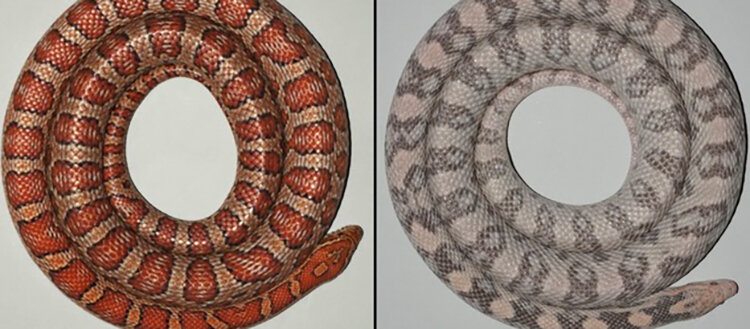#Snakes reveal the origin of skin colours

“#Snakes reveal the origin of skin colours”

The skin color of vertebrates depends on chromatophores—cells found in the superficial layers of the epidermis. A team of specialists in genetic determinism and color evolution in reptiles from the University of Geneva (UNIGE) is studying the wide variety of colors sported by different individuals within the corn snake species. The research, published in the journal PNAS, demonstrates that the dull color of the lavender variant of corn snake is caused by the mutation of a gene involved in forming lysosomes, the “garbage disposal” vesicles of cells. This single mutation is enough to affect every skin color, demonstrating that both the reflective crystals and pigments are stored in lysosome-related vesicles. The UNIGE study marks a significant step forward in our understanding of the origin of colors and patterns in the skin of vertebrates.
The chromatophores are the cells that determine skin color, thanks to the presence of pigments or crystals that reflect light. There are three types of chromatophores: melanophores, which are responsible for the black or brown color; xanthophores, for red and yellow; and iridophores, with crystals that reflect multiple colors. Mammals only have melanophores, while reptiles and fish carry all three types of chromatophore, meaning they can display a very wide variety of colors and color patterns. The pigments of melanophores are known to be stored in organelles known as LROs or lysosome-related organelles. These are small intra- cellular vesicles that have the same origin as lysosomes, the “garbage disposals” that digest the non-functional molecules in cells. On the other hand, the storage location of the red and yellow pigments and crystals in the other types of chromatophore is unknown.
When snakes turn pink
The skin of corn snakes (Pantherophis guttatus) has an orange base, decorated with red dorsal and lateral spots circled in black. The spe- cies can undergo mutations that lead to variations in skin color, with the lavender corn snake being pink with gray spots. The experiments carried out by Athanasia Tzika, a researcher in the Department of Genetics and Evolution in UNIGE’s Faculty of Sciences and her doctoral student Asier Ullate-Agote have identified that these altered colors are due to a single mutation pinpointed in the LYST gene, a gene that regulates lysosome trafficking. “It’s very long-term work, since snakes only have one litter a year. We had to sequence the entire genome of the corn snake and identify all the genes within,” says Tzika
The liver is key
Mutations in the LYST gene in humans cause the Chediak-Higashi syndrome, which is characterized by albinism, an impaired immune sys- tem and an accumulation of enlarged lysosomes. The Geneva team continued its study into corn snakes by analyzing their hepatocytes, the main liver cells in vertebrates, which contain numerous lysosomes. The scientists found that the hepatocytes of lavender corn snakes contain much larger and more aggregated lysosomes. Using electron microscopy, the authors observed that the morphology and arrangement of colored vesicles in all the chromatophores were altered.
The result of evolution
Michel Milinkovitch, a professor in UNIGE’s Department of Genetics and Evolution, explains further: “By characterizing the mutant gene, the study has shown for the first time that the different chromatophores were not created from scratch during evolution but that they all entail a basic mechanism involving LROs.”
Further studies will provide a better understanding of the mechanisms responsible for the extraordinary variety of skin colors and color patterns in vertebrates, features that play a part in functions as diverse and essential as camouflage, intraspecific communication, and protection against the harmful effects of solar radiation.
The corn snake genome sequenced for the first time
Asier Ullate-Agote el al., Genome mapping of a LYST mutation in corn snakes indicates that vertebrate chromatophore vesicles are lysosome-related organelles, PNAS (2020). www.pnas.org/cgi/doi/10.1073/pnas.2003724117
Citation:
Snakes reveal the origin of skin colours (2020, October 5)
retrieved 5 October 2020
from https://phys.org/news/2020-10-snakes-reveal-skin-colours.html
This document is subject to copyright. Apart from any fair dealing for the purpose of private study or research, no
part may be reproduced without the written permission. The content is provided for information purposes only.
For forums sites go to Forum.BuradaBiliyorum.Com
If you want to read more Like this articles, you can visit our Science category.




